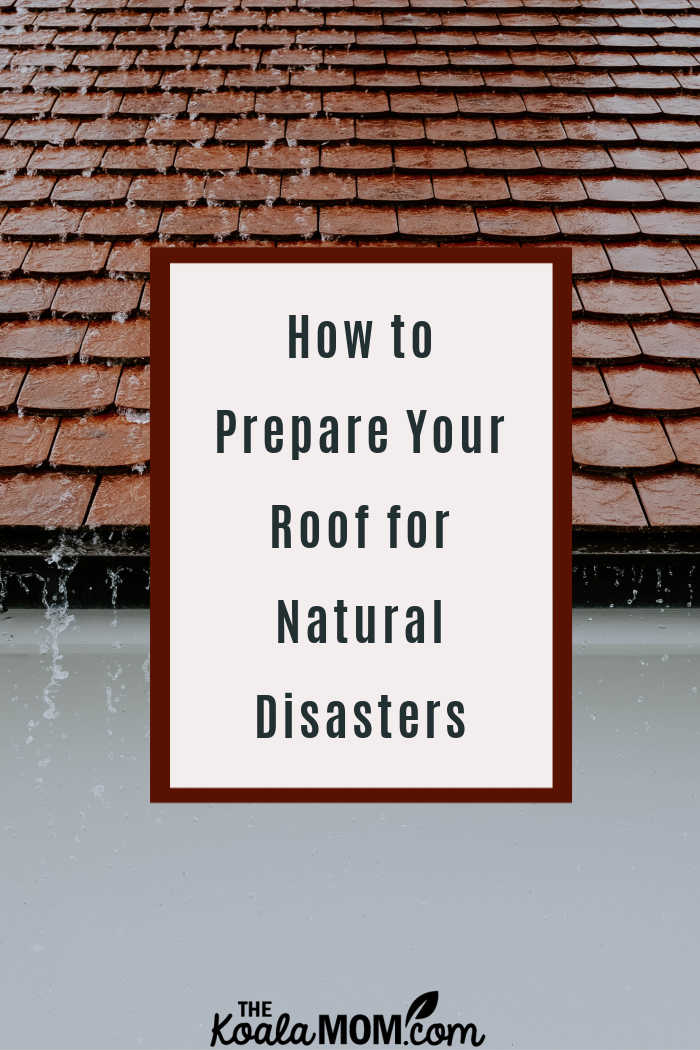Natural disasters can be a major threat to your home, so it’s important that you take the time to prepare your roof for them. It’s also important to take preventative steps ahead of time, so you’ll be prepared if disaster strikes. Here are a few steps you can take to protect your roof from damage and ensure that it stays in good condition after any storm or other natural disaster.
Living here in BC, we don’t experience tornadoes or tsunamis or other natural disasters. However, the “atmospheric river” that rolled through last November left our roof leaking. We lived in a 60-year-old house that is now torn-down so there was little I could do about the roof, but otherwise I would have spent this summer fixing that roof in preparation for more heavy rainstorms this winter.

This post contains affiliate links; as an Amazon associate, I earn from qualifying purchases.
1. Hire contractors to perform regular maintenance on your roof
This is an important step for preventing damage in the first place, and it can also help you spot any signs of damage that may lead to a problem in the future. Work with contractors who are experienced and have the knowledge to identify potential issues, so you know your roof is safe. A contractor with years of experience will notice problems on your roof that may escape your notice.
Experts from Master Roof Contracting say that regular maintenance is essential to keeping your roof in good condition. While you may be able to perform some maintenance tasks yourself, such as cleaning off your gutters and inspecting the condition of your roof, you should also have your roof inspected on a regular basis.
2. Get high-quality materials for your roof
Even if you already have a good roof, it’s important that you use high-quality materials when replacing or repairing damaged areas of your roof. This will help protect against leaks or other problems that may arise from accidents or natural disasters down the road. For example, look for an Ocean County roofing company or one near you to ensure expert guidance and quality workmanship for your roofing needs. Working with experienced professionals can help extend the lifespan of your roof and maintain your home’s structural integrity.
Additionally, working with professionals when installing new materials will ensure that the materials are installed correctly and effectively. When choosing roofing materials, do your research to make sure you are getting the best quality materials at a fair price. It’s also a good idea to talk to previous customers about the contractors you are considering, so you can get an idea of their experience working with that particular company.
3. Have emergency supplies on hand
If disaster does strike, you’ll be better prepared if you’ve already stocked up on supplies like tarps, roofing nails, and other tools for repair work. Keep these items in a safe place where they can easily be accessed in case of an emergency (like that atmospheric river last winter!). This will make it easier for you to respond quickly and take the steps necessary to repair your roof.
It’s also helpful to have an emergency plan in place so that you can act quickly if disaster strikes. Also, keep important documents (such as your insurance information) in a safe place that’s easy to access in case of an emergency.
Having a good roofing contractor on speed dial can also save you time and stress when urgent repairs are needed. If you’re unsure about the condition of your roof, reach out to a trusted professional for a quote on any necessary repairs or upgrades. Taking these proactive steps now can prevent costly damage and keep your home safe during extreme weather conditions.
4. Stay vigilant and keep an eye on your roof
It’s important to remain alert to any changes or issues that may arise with your roof. This means monitoring your roof closely and being ready to take action if you spot any damage or other issues. Taking these steps will help ensure that your roof is well-protected against potential damage from natural disasters, while also enabling you to act quickly in case of an emergency. Additionally, keeping an eye on your roof will help you maintain it in good condition and identify any issues over time.
5. Make sure your attic is properly ventilated
If there is too much moisture in your attic, this can lead to problems with your roof. To prevent this, be sure that your attic is properly ventilated and that there isn’t too much moisture in the space. This will help protect your roof from problems that could arise from excess moisture, as well as prevent other issues with your home.
If you notice any signs of moisture damage in your attic, such as mold or water stains on the ceiling, be sure to address this right away. Also, consider installing a dehumidifier in your attic to remove excess moisture and prevent damage.
6. Have an emergency plan in place
It’s important to be prepared for any disasters that may arise, including those related to your roof. One way to do this is by having home repair emergency plan in place that outlines what you need to do when disaster strikes. This can include steps such as contacting your insurance company, reporting the incident to local authorities, and hiring professionals for repairs if necessary. By being prepared for emergencies, you can help minimize damage and take action quickly in case of any problems.
Following these tips can help ensure that your roof is well-prepared against natural disasters and other potential issues. Remember to work with experienced contractors who are knowledgeable about roofing issues, and be sure to keep a close eye on your roof over time so that you’re ready to take action if any problems arise. With these tips, you can provide your roof with the best possible protection against damage from natural disasters and other issues.

No Responses Yet